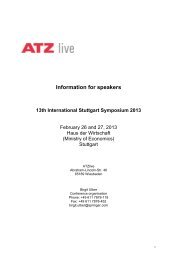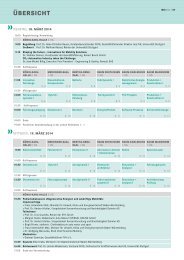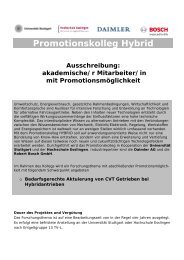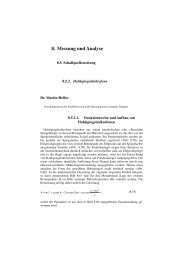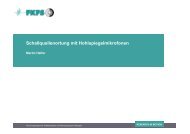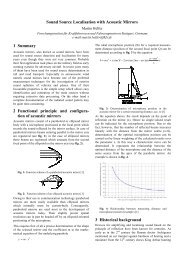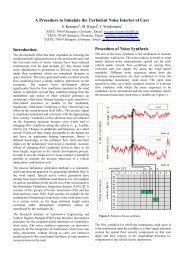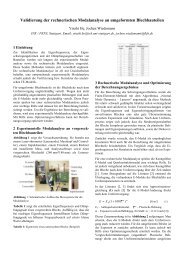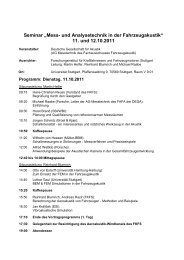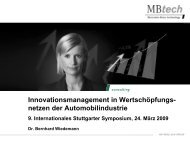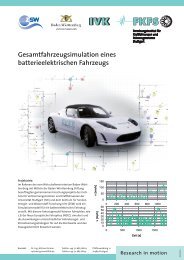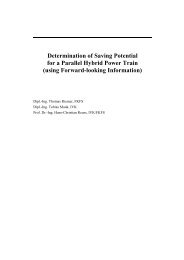An incremental learning method for foresight information ... - FKFS
An incremental learning method for foresight information ... - FKFS
An incremental learning method for foresight information ... - FKFS
You also want an ePaper? Increase the reach of your titles
YUMPU automatically turns print PDFs into web optimized ePapers that Google loves.
<strong>An</strong> <strong>incremental</strong> <strong>learning</strong> <strong>method</strong> <strong>for</strong><br />
<strong>for</strong>esight in<strong>for</strong>mation used in predictive<br />
driving strategies<br />
M. Sc. <strong>An</strong>ne Carlsson, University of Stuttgart, IVK, Automotive Software and Mechatronics<br />
Prof. Dr.-Ing. H.-C. Reuss, University of Stuttgart, IVK, Chair of Automotive Mechatronics
Abstract<br />
Abstract<br />
It has often been shown that <strong>for</strong>esight in<strong>for</strong>mation can improve fuel efficiency and com<strong>for</strong>t<br />
functions as well as active and passive safety systems. In this paper it will be shown how a<br />
database containing roadside in<strong>for</strong>mation of a frequently driven route can be automatically<br />
generated and continually updated in the vehicle during the drive. The identified road<br />
characteristics such as curves, slopes, and speed in<strong>for</strong>mation can be used as prediction or<br />
<strong>for</strong>esight in<strong>for</strong>mation in subsequent drives along the route. The situation identification<br />
algorithms used in the system presented here base on standard sensors found in vehicles<br />
equipped with an electronic stability system and ABS. Additionally a positioning system such<br />
as GPS is required to define the geographical position of the identified road or traffic situation.<br />
<strong>An</strong> identified event such as a curve in the road or a steep uphill section can in terms of memory<br />
capacity be efficiently described with a set of attributes; geographical position, magnitude,<br />
number of observations, and date and time in<strong>for</strong>mation of the observation. This in<strong>for</strong>mation<br />
can be stored in a vehicle individual database with an analogous structure. During each drive<br />
this database can be continually extended and updated by comparing newly identified events<br />
with equivalent events already existing in the database. The development of the identification<br />
and comparison algorithms described here bases on real test drive data, per<strong>for</strong>med through<br />
funding from the Geschwister-Heine Foundation and the Friedrich- und Elisabeth-Boysen<br />
Foundation.<br />
1 Introduction<br />
Since the ABS (anti-lock braking system) became available, driver assistance systems continue<br />
to have a central part by the development of new vehicles. A variety of (assistance) systems <strong>for</strong><br />
increased com<strong>for</strong>t, safety and fuel economy have since then been introduced in the vehicles.<br />
Some systems worth to mention are Adaptive Cruise Control (ACC), Advanced Front Lighting<br />
(AFL), systems <strong>for</strong> predictive gear shifting, electronic stability systems and curve speed<br />
warning etc. [15][16][19]. All these systems base on additional sensor integrated in the vehicle.<br />
These sensors measure the actual state of the vehicle and the systems can react accordingly.<br />
Many previous research projects have shown that with in<strong>for</strong>mation about the road ahead, i.e.<br />
<strong>for</strong>esight in<strong>for</strong>mation, the function of some of these systems could be greatly improved<br />
[2][3][18]. These systems usually base on the expectation that future digital maps will contain<br />
the necessary three dimensional road in<strong>for</strong>mation or that the required in<strong>for</strong>mation will be<br />
available through communication with intelligent infrastructure [4][22]. Today however, a<br />
great amount of roadside in<strong>for</strong>mation relevant <strong>for</strong> these applications is still lacking. The major<br />
challenge <strong>for</strong> the map vendors is the collecting of data and keeping it up to date <strong>for</strong> a useful<br />
support [5][17]. This turns out to be both difficult and expensive. During the years some<br />
projects were initiated to find <strong>method</strong>s to gather the in<strong>for</strong>mation needed. Some of the <strong>method</strong>s<br />
base on so called floating car data [1][6], others on additional sensors fitted to the vehicle, e.g.<br />
radar and cameras [7][14].
Curvature<br />
In this paper a further <strong>method</strong> <strong>for</strong> the collecting and actualisation of <strong>for</strong>esight in<strong>for</strong>mation will<br />
be discussed. The <strong>method</strong> bases on the fact that many vehicles repeatedly travel the same route,<br />
i.e. commuter vehicles, public transport or commercial vehicles. With this approach the system<br />
can “memorise” or “learn” the characteristics of the driven route – just as an observant driver<br />
would do. The learnt in<strong>for</strong>mation can then be used as <strong>for</strong>esight in<strong>for</strong>mation in subsequent<br />
drives along a particular route – just as the <strong>for</strong>ward looking driver would do. Possible fields of<br />
application, beside fuel efficient power train control, could be improved curve speed warning,<br />
adaptive headlight control and predictive gear selection, as well as improved controlling of the<br />
energy flow in hybrid powered vehicles.<br />
The approach presented here claims to be cheaper and more flexible than many other systems<br />
in this category. The reasons <strong>for</strong> this are that the system only employs sensors counting more<br />
or less to standard equipment in the vehicles today, and that the collected in<strong>for</strong>mation is limited<br />
to but focused on the part of the road network where the vehicle is primarily moved. Hence the<br />
amount of data to be stored can be limited to the, <strong>for</strong> a particular vehicle / driver, truly relevant<br />
in<strong>for</strong>mation.<br />
In Figure 1 a flow diagram describing the process of a <strong>learning</strong> vehicle <strong>for</strong> <strong>for</strong>ward-looking<br />
driving can be seen. During a drive sensors, e.g. yaw rate and acceleration sensors, gather<br />
in<strong>for</strong>mation about vehicle movements and road characteristics along the travelled road. The<br />
gathered data are directly analysed and features in the measurement data indicating relevant<br />
situations are extracted. With the positioning system each identified situation (a so called<br />
“event”) can be associated with a geographical position. Based on this position, the new event<br />
data are compared to the data of equal event types identified at the same geographical position<br />
during previous drives, i.e. data already existing in the vehicle internal database. If the<br />
compared events correlate the database is updated accordingly. On the other hand, if no<br />
parallels can be identified, the new data are simply added to the database as a new event. The<br />
updated or added data will then in a similar way be involved in future comparisons with newly<br />
identified events. Each time the database is updated, a status or counter value <strong>for</strong> the revised<br />
event is incremented. This attribute gives in<strong>for</strong>mation about the probability that the identified<br />
situation is correctly recognised. The in<strong>for</strong>mation in the database from events marked as “true”<br />
can be released as <strong>for</strong>esight in<strong>for</strong>mation <strong>for</strong> different control applications in the vehicle. The<br />
main focus of this paper stays on the <strong>learning</strong> process itself, i.e. the updating of the database<br />
containing the roadside in<strong>for</strong>mation.<br />
2 Implementation of the Learning System<br />
The <strong>learning</strong> system presented here is implemented in C++ with a direct interface <strong>for</strong> reading<br />
from the CAN bus of the host vehicle, currently using the API provided from Vector<br />
In<strong>for</strong>matik GmbH. The identified event data is stored in a database based on MySQL. A<br />
graphical display of the result is implemented with Qt® by TrollTech. The ambition is to<br />
develop a system capable of real-time application and to be independent of plat<strong>for</strong>m. The<br />
development of the system algorithms bases on real measurement data, collected during test<br />
drives over several thousands of kilometres. The realisation of the <strong>learning</strong> system is<br />
financially supported by the Geschwister-Heine Foundation and the Friedrich- und Elisabeth-<br />
Boysen Foundation.
Learning<br />
Process<br />
Figure 1: Flow diagram <strong>for</strong> a <strong>learning</strong> vehicle <strong>for</strong> <strong>for</strong>ward-looking driving<br />
3 Situation detection<br />
Situation detection<br />
The situation detection algorithms <strong>for</strong> the <strong>learning</strong> system presented in this paper base apart<br />
from engine control and drive train in<strong>for</strong>mation only on standard sensors found in vehicles<br />
equipped with e.g. ESP and ABS. I.e. sensors <strong>for</strong> longitudinal and lateral acceleration, yaw<br />
rate, wheel speed and steering wheel angle. To be able to geographically position the identified<br />
situations along the route, also a positioning system such as GPS, or in the next future the<br />
Galileo system, is necessary [9].<br />
For clarification purposes a couple of definitions used throughout this paper will be introduced;<br />
a curve, a slope or a change in speed limits along the investigated road section will be referred<br />
to as a specific situation type. As a road section could contain several occurrences of a<br />
particular situation type, a single occurrence will be referred to as an event of a defined<br />
situation type.<br />
The diagrams in Figure 2 illustrate some signals measured during a number of independent<br />
drives as function of the driven distance. The repeated pattern of the signals indicates that the<br />
characteristics of the driven road section can be found by inspecting data from a number of<br />
drives.<br />
3.1 Curvature<br />
Sensor Data Data<br />
Conditioning<br />
Situation<br />
Verification<br />
DB<br />
Route<br />
Characteristics<br />
Situation<br />
Identification<br />
Applications using<br />
<strong>for</strong>esight in<strong>for</strong>mation<br />
Data Fusion<br />
Feature<br />
Extraction<br />
With the previous mentioned sensors, the curvature of a driven road section can be determined<br />
in various ways. One possibility would be to use the lateral acceleration of the vehicle. Fitted<br />
to the vehicle, such sensors would measure the total lateral acceleration of the vehicle and
Curvature<br />
would hence include the lateral gradient of the road. Without in<strong>for</strong>mation about this quantity,<br />
the curvature determined from the lateral acceleration would only be valid along levelled road<br />
sections. <strong>An</strong>other possibility would be the steering wheel angle. This measurement though, is<br />
in addition sensitive to e.g. side wind, there<strong>for</strong>e not always reliable. A third option would be to<br />
use the in<strong>for</strong>mation from the yaw rate sensor. Assuming that the examined test drives were<br />
conducted without skidding, it has been shown that the curvature of the driven road can be<br />
satisfactorily identified using solely the in<strong>for</strong>mation from the yaw rate sensor.<br />
curvature [m -1 ]<br />
velocity [m/s]<br />
lat acc [m/s²]<br />
long acc [m/s²]<br />
30<br />
20<br />
10<br />
0<br />
0 1000 2000 3000 4000 5000 6000<br />
4<br />
2<br />
0<br />
-2<br />
-4<br />
0 1000 2000 3000 4000 5000 6000<br />
4<br />
2<br />
0<br />
-2<br />
-4<br />
0 1000 2000 3000 4000 5000 6000<br />
0.01<br />
0<br />
-0.01<br />
0 1000 2000 3000<br />
distance [m]<br />
4000 5000 6000<br />
Figure 2: Some of the signals investigated <strong>for</strong> situation identification. The repeated pattern from<br />
different drives indicates that the characteristics of the driven road to a certain extent can be<br />
determined.
3.2 Road gradient<br />
Data reduction<br />
The longitudinal gradient, i.e. the slope, of the driven road can theoretically be identified using<br />
in<strong>for</strong>mation about the total longitudinal acceleration of the vehicle, together with the<br />
acceleration of the vehicle due to the selected velocity. This measurement though, is sensitive<br />
to e.g. noise, the pitch motion of the vehicle and the oscillations induced through interruption<br />
in the traction <strong>for</strong>ce. In [11], [19] and [20] further <strong>method</strong>s <strong>for</strong> the determination of the road<br />
gradient based on state observers are discussed.<br />
3.3 Speed limit<br />
While driving in urban areas the freedom of selecting speed and driving manner is usually<br />
strongly limited. Looking at the velocity data in Figure 2, it can be seen that the velocity<br />
chosen by different drivers and at different drive occasions along a certain road section have a<br />
high level of agreement. This means that the appropriate velocity can be pretty well estimated<br />
<strong>for</strong> this road segment. However, the selected speed may vary with both weekday and daytime.<br />
I.e. a lower speed might be more appropriate at rush hour compared to the speed selected (or<br />
allowed) at times <strong>for</strong> lower traffic density. Hence the time and date in<strong>for</strong>mation of the drive is<br />
required. Also in<strong>for</strong>mation about the type of road is relevant <strong>for</strong> making a suitable estimate of<br />
the valid speed limit. It has been shown that with in<strong>for</strong>mation of selected gear, number of<br />
standstills, standstill time, and maximum and minimum speed over a certain road segment, an<br />
adequate rating of the road type can be made, e.g. motorway, highway or urban area.<br />
Other interesting “situations” that can be recognised using only the previously mentioned<br />
sensors are the positions <strong>for</strong> traffic lights and intersections. However, further discussions about<br />
situation detection <strong>method</strong>s go beyond the scope of this paper. In [8], [12] and [13] are some<br />
supplementary <strong>method</strong>s <strong>for</strong> situation identification and sensor fusion discussed.<br />
4 Data reduction<br />
At the bottom of Figure 2 the road curvature calculated from yaw rate and velocity in<strong>for</strong>mation<br />
<strong>for</strong> 4 independent drives along the same road section is shown. It can be seen that the<br />
calculated curvature is similar throughout the drives. This indicates that the probability is high<br />
that a situation, i.e. a curve, can be correctly identified in all drives. A curve event is detected<br />
when the absolute value of the curvature exceeds a set limit. It can also be seen that the<br />
curvature or curve radius hardly ever stays constant throughout the whole curve. Hence it is not<br />
sufficient to represent a curve with just a single value <strong>for</strong> the curve radius. The application<br />
“curve light” requires <strong>for</strong> example in<strong>for</strong>mation about the actual curvature along the whole<br />
extent of the curve <strong>for</strong> an appropriate adjusting of the head lights. To allow <strong>for</strong> this, the<br />
complete measurement data of the identified event need to be stored in the vehicle internal<br />
database. However, this would require great memory resources <strong>for</strong> each single event. The same<br />
problem would also apply <strong>for</strong> slopes and speed limit changes.<br />
To be able to store the data of the identified events in a memory efficient way, the amount of<br />
measured data points needs to be reduced, however without loosing in<strong>for</strong>mation. Instead of
Speed limit<br />
storing all measurement values, the observations may be described through a mathematical<br />
model whose characterising parameters can be stored. This so called curve fitting <strong>method</strong> also<br />
works as a kind of filter on the observations to remove too large and unrealistic variations in<br />
the measurement data. This is valid under the assumption that situations of this type (curves,<br />
slopes, etc) in the reality have a smooth characteristic. As a result each set of measurement data<br />
can be described with only a few values, i.e. the parameters of the specified approximation<br />
function. The difficulty with this <strong>method</strong> is the automatic selection of a suitable fit function,<br />
linear or nonlinear, and its degree. No graphing or analysis software can pick a model <strong>for</strong> the<br />
given data – it can only help in differentiating between models. With a certain understanding of<br />
the underlying properties of the measurement data, an adequate model can be chosen. Through<br />
an analysis of the observations, in terms of e.g. local and global minima and maxima, a<br />
decision of the model type and degree can be made. As can be seen in Figure 3, each identified<br />
event of a certain situation type can be approximated with a linear or a nonlinear function of a<br />
specific degree, e.g. a polynomial or rational function, without too much loss of in<strong>for</strong>mation.<br />
Each fit, i.e. each approximation, can be validated through analysing the Goodness of Fit. <strong>An</strong>d<br />
when necessary, the fit is repeated with a slightly different model until a satisfying result is<br />
achieved. The Goodness of Fit (GOF) gives a measure on how good a statistical model fits a<br />
set of observations (true values). The GOF typically summarises the discrepancy between<br />
observed values and the values predicted under the model in question. For this application the<br />
GOF analysis includes 4 measures; the sum of squares due to error (SSE), statistics on how<br />
successful the fit is in explaining the variation of the data (R²), a measure <strong>for</strong> the quality of the<br />
fit when adding additional coefficients to the model (adjusted R²) and finally the root mean<br />
squared error (RMSE). For a good fit SSE and RMSE should be close to 0, and R² and adjusted<br />
R² should be close to 1.<br />
The real measurement data <strong>for</strong> some events shown in Figure 3 together with the<br />
approximations are summarised in Table 1. In the table the identified curves and their fit<br />
functions are listed together with the result of the goodness of fit analysis. Rat 55 means a<br />
rational function with both numerator and denominator of degree 5. Poly 9 means a polynomial<br />
of degree 9. According to this <strong>method</strong>, the only data that need to be stored in the database <strong>for</strong><br />
each event of a specific situation type are the start and end positions, the length, the type of fit<br />
model, the degree of the used fit model and the result, i.e. the parameters, of the fitted function.
curvature [m -1 ]<br />
curvature [m -1 ]<br />
curvature [m -1 ]<br />
0.2<br />
0.15<br />
0.1<br />
0.05<br />
0.02<br />
0.015<br />
0.01<br />
0.005<br />
curve 1<br />
rat55<br />
0<br />
0 10 20 30<br />
0<br />
160 170 180 190 200<br />
0<br />
-0.005<br />
-0.01<br />
poly7<br />
curve 3<br />
curve 5<br />
poly8<br />
-0.015<br />
240 260 280<br />
distance [m]<br />
300 320<br />
0.05<br />
0<br />
-0.05<br />
-0.1<br />
-0.15<br />
curve 2<br />
Data reduction<br />
poly9<br />
-0.2<br />
60 70 80 90<br />
0.08<br />
0.06<br />
0.04<br />
0.02<br />
poly6<br />
curve 4<br />
0<br />
220 230 240 250<br />
x 10-3 curve<br />
-2<br />
-3<br />
-4<br />
6<br />
poly7<br />
-5<br />
360 370 380 390<br />
distance [m]<br />
Figure 3: Curve fitting. Real measurement data (red) approximated with different linear and nonlinear<br />
models (blue). Rat55 = rational function of degree 5 over degree 5, poly9 = polynomial<br />
function of degree 9.
Speed limit<br />
Table 1: Summary of curve fitting and goodness of fit analysis <strong>for</strong> the real measurement data<br />
shown in Figure 3<br />
Curve Fit Function SSE R² Adj. R² RMSE<br />
1 Rat 55 0. 0046 0.9971 0.9970 0.0032<br />
2 Poly 9 0.0098 0.9677 0.9659 0.0079<br />
3 Poly 7 1.77e-5 0.9974 0.9973 3.24e-4<br />
4 Poly 6 4.15e-4 0.9968 0.9968 0.0013<br />
5 Poly 8 2.09e-5 0.9922 0.9920 2.85e-4<br />
6 Poly 7 2.30e-6 0.9247 0.9193 1.54e-4<br />
5 Database structure<br />
For each identified event, i.e. a specific curve or slope along the driven route, only a few<br />
attributes need to be stored (<strong>for</strong> future use) in the vehicle internal database; start position, end<br />
position, geographical length of the event, type of fit model, degree of fit function, and the<br />
characterising fit parameters. The structure of the implemented database is shown in Figure 4.<br />
Beside the above mentioned attributes, each event has also a date and time stamp and a counter<br />
variable.<br />
The date and time in<strong>for</strong>mation of the events have two purposes. The first one is to account <strong>for</strong><br />
the differences in some of the identified events due to week day and time of the day, e.g.<br />
recommended or suggested velocity at rush hour compared to times with a lower level of<br />
traffic density. The second purpose with the date in<strong>for</strong>mation is to be able to keep the whole<br />
database up to date. Too old elements in the database without a recent update can be removed<br />
from the database after a certain time, e.g. 6 months.<br />
The counter variable <strong>for</strong> each event is important to keep track on how many times a certain<br />
event at a certain geographical position was identified in an equivalent way. The value of the<br />
counter together with the total number of drives along a certain route, give the probability that<br />
this event was accurately identified. If the probability is high, the event can be approved as<br />
valid <strong>for</strong>esight in<strong>for</strong>mation and can be released <strong>for</strong> usage in assistance systems.
Table: CurveCtrl<br />
RouteNo<br />
CurveNo<br />
Table: Route<br />
Table: SlopeCtrl<br />
Table: SpeedCtrl<br />
Table: Curve Table: Slope Table: Speed Table: TrafLight<br />
Key: CurveNo<br />
Curve_StartPos_X<br />
Curve_StartPos_Y<br />
Curve_EndPos_X<br />
Curve_EndPos_Y<br />
Curve_Length<br />
Curve_DriveDir<br />
Curve_FitFunction<br />
Curve_Param<br />
Curve_Date<br />
Curve_Counter<br />
RouteNo<br />
SlopeNo<br />
Key: SlopeNo<br />
Key: RouteNo<br />
Route_StartPoint_X<br />
Route_StartPoint_Y<br />
Route_EndPoint_X<br />
Route_EndPoint_Y<br />
Route_Length<br />
Route_Date<br />
Slope_StartPos_X<br />
Slope_StartPos_Y<br />
Slope_EndPos_X<br />
Slope_EndPos_Y<br />
Slope_Length<br />
Slope_FitFunction<br />
Slope_Param<br />
Slope_Date<br />
Slope_Counter<br />
Route_Counter<br />
RouteNo<br />
SpeedCtrlNo<br />
Key: CurveNo<br />
Speed_StartPos_X<br />
Speed_StartPos_Y<br />
Speed_EndPos_X<br />
Speed_EndPos_Y<br />
Speed_Length<br />
Speed_Value<br />
Speed_Time<br />
Speed_Date<br />
Speed_Counter<br />
Database structure<br />
Table: TrafLightCtrl<br />
RouteNo<br />
TrafLightNo<br />
Key: TrafLightNo<br />
TrafLight_StartPos_X<br />
TrafLight_StartPos_Y<br />
TrafLight_EndPos_X<br />
TrafLight_EndPos_Y<br />
TrafLight_Value<br />
TrafLight_Time<br />
TrafLight_Date<br />
TrafLight_Counter<br />
Figure 4: Database structure used <strong>for</strong> storing and managing in<strong>for</strong>mation from events identified<br />
during a drive.<br />
The database structure allows the system to contain several separate events of various situation<br />
types <strong>for</strong> one specific route, as well as a number of different routes. The various routes could<br />
<strong>for</strong> example be categorised as home – workplace, home – food store, workplace – fitness studio<br />
or home – grandparents’ home. The motivation <strong>for</strong> this is that just as a single route could<br />
contain many events of each specific situation type, one specific event could also appear in
Speed limit<br />
more than one of the separate routes (in case some sections of the routes coincide). Using the<br />
database structure presented here each event will exist only once in the database, but could still<br />
be associated with several routes.<br />
6 Event comparison<br />
To keep the database up to date during each drive, it is necessary to compare the existing<br />
entries in the database with the newly identified ones. If required, the existing database entries<br />
are changed according to the new in<strong>for</strong>mation, otherwise the new data is simply added to the<br />
database as a new piece of in<strong>for</strong>mation. The sensor data is evaluated online during the drive.<br />
When an event is recognised, the relevant measurement data is stored temporarily until the<br />
whole event is recorded. The next step is to compare this data with previously collected data.<br />
This comparison can be per<strong>for</strong>med “offline” but during the drive, basically while waiting <strong>for</strong><br />
the next event to occur.<br />
Each time a new event is recognised during a drive, a search algorithm is started in the<br />
database to find all comparable events already in it. The search algorithm is fed with the<br />
situation type and the geographical start and end positions of the new event, e.g. “curve<br />
beginning at position (xstart,ystart) and ending at position (xend,yend)”. Some curve events<br />
identified during two separate drives along a defined road section are illustrated in Figure 5.<br />
The three identified curves are found at approximately the same geographical position in both<br />
of the drives. The circles represent the accepted tolerance of the start and end positions when<br />
searching the database <strong>for</strong> comparable events. Both curve number 2 and curve number 3 have<br />
the start and end positions within the tolerance while curve number 1 has none within the<br />
tolerance.
Latitude [°]<br />
48.748<br />
48.748<br />
48.747<br />
48.747<br />
48.746<br />
curve 1<br />
curve 2<br />
curve 3<br />
Event comparison<br />
1st drive<br />
2nd drive<br />
9.1100 9.1105 9.1110 9.1115 9.1120<br />
Longitude [°]<br />
9.1125 9.1130 9.1135 9.1140<br />
Figure 5: Evaluation of matching start and end positions of independently identified events<br />
If one or more events of the requested situation type are found in the database with the start or<br />
end position within the range of tolerance of the searched position, these events are retrieved<br />
from the database to be individually compared with the newly recognised event. The<br />
comparison to check the correspondence of the event data is done by checking the correlation<br />
between the two sets of data. The correlation of two data sets is calculated according to<br />
equation 1, where σX denotes the standard deviation and cov ( X , Y ) is the covariance of these<br />
two variables.<br />
( X , Y )<br />
cov<br />
R(<br />
X , Y ) = (1)<br />
σ σ<br />
X<br />
Y<br />
The result of a correlation, the correlation coefficient, R, ranges from -1 to 1. The closer R is to<br />
+1 or -1, the more closely the two variables are related. If R is close to 0 there is no<br />
relationship between the variables. If R is positive, it means that as one variable gets larger, the<br />
other gets larger. If R is negative, it means that as one gets larger, the other gets smaller. When<br />
the correlation coefficient <strong>for</strong> the compared events is larger than a given threshold value (close<br />
to 1), it can be assumed that the variables are representing the same event in the same way.<br />
Otherwise it has to be assumed that the event was measured / identified in a different way in<br />
the two independent drives. To determine the correlation it is necessary to calculate the<br />
predicted data, based on the parameters of the approximating model. This is done by evaluating<br />
the fit function <strong>for</strong> each of the events to be compared with its respective parameters, start<br />
values and end values <strong>for</strong> a certain resolution. The correlation in<strong>for</strong>mation <strong>for</strong> the curves<br />
shown in Figure 5 are summarised in Table 2. The correlation coefficients of the data sets<br />
representing the second and third curve event respectively are close to 1. Hence the<br />
relationship between each of the two curve measurements is statistically confirmed. In Figure 5
Speed limit<br />
it can be seen that curve number 1 was identified as a much longer curve during the second<br />
drive compared to the first drive and consequently the correlation coefficient is low.<br />
Table 2: Summary of correlation in<strong>for</strong>mation <strong>for</strong> three different events identified during two<br />
independent drives<br />
Curve number Data set Fit function Correlation<br />
coefficient<br />
1 1 st Drive Poly 7 0.2235 No<br />
2 nd Drive Poly 7<br />
2 1 st Drive Poly 6 0.9734 Yes<br />
2 nd Drive Poly 6<br />
3 1 st Drive Poly8 0.9081 Yes<br />
2 nd Drive Poly6<br />
7 Database update<br />
“Good<br />
Correlation”<br />
In Figure 6 a flow diagram showing the update process of the database can be seen. The<br />
comparison of the two data sets is carried out by examining the correlation of the data. As<br />
discussed in the previous section, it can be assumed that two sets of data represent the same<br />
event when the calculated correlation coefficient is larger than a set threshold value. In this<br />
case (following the left hand branch of the flow diagram in Figure 6) the examined entry found<br />
in the database should be updated with a combination of the in<strong>for</strong>mation from both events,<br />
thereby not loosing any significant in<strong>for</strong>mation. The start position of the updated event can be<br />
set as the mean value of the beginning positions of the data sets to be combined. In the same<br />
way the new end position can be determined. The process <strong>for</strong> the combining of the two sets of<br />
approximated measurement data is not trivial and will be further explained below. When all<br />
attributes of the event are newly determined, the examined entry in the database is updated<br />
accordingly. Finally the counter of the updated event is increased with 1.<br />
If the correlation coefficient on the other hand is lower than the set threshold value (right hand<br />
branch), it can be assumed that the new event is differently measured than in previous drives,<br />
or that a completely new event was found (at the same geographical position as an earlier event<br />
of this type). Consequently this new event should be added to the database “as is”, as a new<br />
entry. In this case its counter is set to 1, which indicates that the event was measured /<br />
identified in this particular way <strong>for</strong> the first time. Also this conflicting data need to be stored,<br />
as it could imply a change in road or traffic conditions.
Event data<br />
from DB<br />
Combine EvDB & EvCurrent<br />
� EvUpdate<br />
Set EvUpdate.counter =<br />
EvDB.counter+1<br />
Replace EvDB in database<br />
with EvUpdate<br />
Calculate<br />
Correlation R<br />
Yes No<br />
R > limit<br />
Figure 6: Flow diagram <strong>for</strong> the process of updating the database<br />
Event data from<br />
current drive<br />
Set EvCurrent.counter = 1<br />
Store EvCurrent in DB<br />
Database update<br />
When two compared events are found to correlate, their data sets need to be combined into one.<br />
The details to the highlighted box in Figure 6 are shown in Figure 7. It represents a <strong>method</strong> <strong>for</strong><br />
merging two sets of event data. Principally an (weighted) average of the examined data needs<br />
to be created. In the trivial case, the same approximation model was used to approximate the<br />
real measurement values <strong>for</strong> both of the events (curve number 2 in Table 2). In this case the<br />
new parameters can simply be calculated as an element wise average of the parameters <strong>for</strong> the<br />
compared events. In the non-trivial case different fitting models were used <strong>for</strong> the<br />
approximation (curve number 3 in Table 2). In this case an average of the predicted values<br />
needs to be <strong>for</strong>med and it is required to carry out a new fitting process to obtain a new<br />
parameter set describing the averaged data. For the curve fitting, the approximation models<br />
used <strong>for</strong> each of the compared events are considered. The new fitting function is selected as the<br />
one approximation giving the best result of the goodness of fit analysis.
Speed limit<br />
Event data<br />
from DB<br />
Yes No<br />
Same fit<br />
function ?<br />
Calculate average of<br />
fit parameters <strong>for</strong><br />
EvDB & EvCurrent<br />
Replace fit parameters of<br />
EvDB with new fit<br />
parameters<br />
Retrieve fit functions<br />
Fit average with<br />
fit model 1<br />
Calculate GOF<br />
<strong>for</strong> Fit 1<br />
Yes<br />
Replace fit parameters of EvDB with<br />
new parameters from Fit 1<br />
Calculate average of<br />
predicted values of<br />
EvDB & EvCurrent<br />
GOF1 better<br />
than GOF2 ?<br />
Event data from<br />
current drive<br />
Fit average with<br />
fit model 2<br />
Calculate GOF<br />
<strong>for</strong> Fit 2<br />
Replace fit parameters of EvDB with<br />
new parameters from Fit 2<br />
Figure 7: Flow diagram showing the combining process of two correlating data sets.<br />
No
8 Results<br />
Results<br />
The result of the database updating process is illustrated in Figure 8. The event in<strong>for</strong>mation<br />
bases on measurement data from four different test drives. The thickest lines represent events<br />
identified in an equal manner in 3 of the 4 examined test drives. The thinner the lines the fewer<br />
are the times that a certain event was recognised in an equal way.<br />
In the lower right diagram it can be seen that even though some of the events look very similar<br />
they were still recognised as different events (at the same geographical position). This<br />
problematic arises as the set limits <strong>for</strong> what “a good correlation” is or <strong>for</strong> when “a matching<br />
starting point” are found, are hard coded. Using a fuzzy approach <strong>for</strong> the decision making of<br />
when two sets of event data agree could solve this problem.<br />
In the lower left diagram, the first curve was recognised in one manner 3 of the times and in<br />
another manner 2 of the times, although only a total of 4 test drives have been examined. This<br />
phenomenon can also be explained through the set limits <strong>for</strong> when a pair of event data are<br />
categorised as equal. If the limit is set <strong>for</strong> event data to have at least 85% agreement to<br />
continue the process of combining the examined event data, events with an agreement of<br />
“only” 84.9% would be categorized as different events and hence not combined into one. Due<br />
to this an event with a correlation close to, but below the set limit <strong>for</strong> e.g. a “good correlation”<br />
is added to the database as a new event. As a result similar events identified during later drives<br />
can have more than one matching event in the database. Each of the matching events found in<br />
the database are compared with the newly identified one and updated according to the <strong>method</strong>s<br />
illustrated in Figure 6 and Figure 7.<br />
9 Outlook<br />
A database <strong>for</strong> roadside in<strong>for</strong>mation generated through the <strong>method</strong> discussed in this paper will<br />
be individual <strong>for</strong> each vehicle and dependent on the travel pattern of the driver. Hence the<br />
vehicle will lack <strong>for</strong>esight in<strong>for</strong>mation each time a never driven route is selected. Especially <strong>for</strong><br />
long distance transport, a sharing system of the learnt in<strong>for</strong>mation would improve its<br />
functionality. As a result a new vehicle in a fleet or a new driver could immediately make use<br />
of already learnt roadside in<strong>for</strong>mation collected from another driver/vehicle, without having to<br />
travel the route even once.<br />
Making use of further sensors (preferably already available in the vehicle anyway), such as<br />
short and long range radar or cameras <strong>for</strong> lane detection and night-view, would open up the<br />
possibility <strong>for</strong> extended situation detection. In this case the in<strong>for</strong>mation quality could be greatly<br />
improved.
Speed limit<br />
curvature [1/m]<br />
curvature [1/m]<br />
0.25<br />
0.2<br />
0.15<br />
0.1<br />
0.05<br />
-0.05<br />
0<br />
-0.1<br />
0.15<br />
0.1<br />
0.05<br />
-0.05<br />
0<br />
-0.1<br />
0 100 200 300<br />
distance [m]<br />
400 500 600<br />
0 20 40<br />
distance [m]<br />
60 80<br />
0.08<br />
0.06<br />
0.04<br />
0.02<br />
-0.02<br />
0<br />
1 time<br />
2 times<br />
3 times<br />
200 250<br />
distance [m]<br />
300<br />
Figure 8: Result of the database updating algorithm. Some of the events were even identified in a<br />
similar way during all four of the examined test drives.
10 Bibliography<br />
Bibliography<br />
[1] Netzausgleich Individualverkehr NIV, Result report of sub-project. INVENT –<br />
Intelligent traffic and user-friendly technology, www.invent-online.de. 2005<br />
[2] Neunzig, D.; Benmimoun, A.: Potentiale der vorausschauenden Fahrerassistenz zur<br />
Reduktion des Kraftstoffverbrauchs. Proceedings 11th Aachener Colloquium Fahrzeug-<br />
und Motorentechnik, p. 1205-1238, 2002.<br />
[3] Hettich, G.: Wise <strong>for</strong>esight. paper, DaimlerChrysler Innovation Symposium, Stuttgart,<br />
2002.<br />
[4] Brandstaeter, M.; Prestl, W.; Bauer, G.: Functional Optimization of Adaptive Cruise<br />
Control Using Navigation Data. Paper. Proceedings SAE International, 2004.<br />
[5] Herrtich, R. G.: Digital Road Maps Reveal the Telematic Horizon. Article. ITS America<br />
News, Vol.12 No. 8, 2002.<br />
[6] Lorkowski, S.; Brockfeld, E.; Mieth, P.; Passfeld, B.; Thiessenhusen, K.-U.; Schäfer,<br />
R.-P.: Erste Mobilitätsdienste auf Basis von „Floating Car Data“. Proceedings <strong>for</strong> 4th<br />
Aachener Colloquium "Mobilität und Stadt", Stadt Region Land, 75, p. 93 - 100,<br />
Aachen (Germany), 2003, ISBN 3-88354-140-0.<br />
[7] Wisselmann, D.; Gresser, K.; Spannheimer, H.; Bengler, K.; Huesmann, A.:<br />
ConnectedDrive – ein <strong>method</strong>ischer <strong>An</strong>satz für die Entwicklung zukünftiger<br />
Fahrerassistenzsysteme. BMW Group Forschung und Technik. Proceedings <strong>for</strong><br />
Conference Aktive Sicherheit durch Fahrerassistenz, Garching, 2004<br />
[8] Naab, K.: Sensorik- und Signalverarbeitungsarchitektur für Fahrerassistenz und aktive<br />
Sicherheit. Proceedings <strong>for</strong> Conference Aktive Sicherheit durch Fahrerassistenz,<br />
Garching, 2004.<br />
[9] Zogg, J.-M.: Von GPS zu Galileo – Die Weiterentwicklung der Satelliten-Navigation.<br />
Teil 2: Galileo: Technik und <strong>An</strong>wendungen. Article. Elektronik, No. 5, p. 50 – 56,<br />
2006.<br />
[10] Carlsson, A.; Reuss, H.-C.: A Learning Vehicle <strong>for</strong> Forward-Looking Driving. Paper.<br />
Proceedings VDI conference Steuerung und Regelung von Fahrzeugen und Motoren.<br />
VDI-Bericht 1931, p.109-119, 2006<br />
[11] Hauke, M.: Adaptive Erkennung der Straßenneigung, Thesis work. Inst. für<br />
Verbrennungskraftmaschinen und Thermodynamik, Technical University of Graz,<br />
2003.<br />
[12] Müller, M.; Reif, M.; Pandit, M.; Staiger, W.; Martin, B.: Vehicle Speed Prediction <strong>for</strong><br />
Driver Assistance Systems. Paper. Proceedings SAE International, 2004.<br />
[13] Schammer, A.: Entwurf von Fusionsobjekten für den Einsatz in<br />
Fahrerassistenzsystemen. Thesis work. Accomplished at DaimlerChrysler AG, Research<br />
Division FT3/AA, University of Stuttgart, 2001.<br />
[14] Schmitt, M.; Lorenzen, T.: Visuelle Verkehrszeichenerkennung mit dem Blackfin.<br />
Article. Hanser Automotive, No. 11, p.14-19, 2006.
Speed limit<br />
[15] Amsel, C.; Himmler, A.: Adaptive Lichtregelung: Lichttechnische<br />
Fahrerassistenzsysteme. Article. Hanser Automotive, No. 7-8, p. 36-39, 2006.<br />
[16] Wallaschek, J.; Locher, J.; Strauß, S.: Lichttechnische Fahrerassistenz. Article. ATZ,<br />
No. 3, p. 204-211, 2006.<br />
[17] Khan, M. S.; Herbst, M. R.; Sabel, H.: Erweiterte Datenbasis von Navigationskarten für<br />
Fahrerassistenzsysteme. Proceeding <strong>for</strong> 9th Aachener Colloquium Fahrzeug- und<br />
Motorentechnik, p.643-652, 2000.<br />
[18] Back, M.; Terwen, S.: Prädiktive Regelung mit Dynamischer Programmierung für<br />
nichtlineare Systeme erster Ordnung, Article, Automatisierungstechnik 51, No. 12, p.<br />
547-554, 2003.<br />
[19] Eder, J.; Birner, I.; Schloen, O.; John, T.; Nageleisen, F. : Sequentielles M-Getriebe der<br />
zweiten Generation mit Drivelogic. Article. ATZ, No. 2, p.154-163. 2002.<br />
[20] Halfmann, C.; Holzmann, H.; Isermann, R.; Hamann, C.-D.; Simm, N.: Adaptives<br />
Echtzeitmodell für die Kraftfahrzeugdynamik. Article. ATZ, No. 12, p. 994-1001, 1999.<br />
[21] Eschke, S.; Ploeger, G.: Automotive Applications using satellite based positioning.<br />
Bosch. MSAA Conference, Brussels, 2006.<br />
[22] Schupfner, M.; Artmann, K.: Optimierte Routenkalkulation bei Navigationssystemen.<br />
Article. ATZ elektronik, No. 1, p. 54-61, 2006.



